If you’re old enough to have started your “knife fighting” education before the Internet age, chances are good you developed opinions about the topic based on magazines like Fighting Knives and mail-order catalogs like Delta Press, Loompanics, and of course, Paladin Press. If you’ve stayed with the topic you now look at “knife fighting” as a passé terminology at best — and completely obsolete at worst. The fact is, none of us were ever destined to become leather-cuff-wearing, devil-may-care street samurai. The topic of “knife fighting” was always about self-defense using a blade as a force multiplier… but the latter is an ungainly amalgam, whereas the former sounds exciting and even romantic.
There is nothing exciting or romantic about getting cut up with a knife. I saw a YouTube video of a knife fight in Raval (in Barcelona) recently of the type to give Cold Steel executives manufacturing boners as they try to determine how to market the blades in question. (If the YouTube link included here is broken, it’s because the video was found in violation of YouTube’s Terms of Service.)
The video depicts what is kind of a classic “knife fight” in the sense that neither party wants to have it, at least at first. There’s a guy in a black coat we’ll call Machete Guy who has, natch, a machete. There’s another guy with his coat wrapped around his left arm holding some kind of large Bowie knife or navaja whom we’ll call Knife Guy. The two dance around quite a bit, with Machete Guy making it clear that he’s going to do Knife Guy if Knife Guy doesn’t back off.
 Knife Guy is in full Jets vs Sharks, Dance Dance Revolution mode, and at some point, he’s wounded and starts leaving blood on the street with every step. Despite his wound, he seems eager to rush in despite the tremendous disadvantage he’s at while he’s outside the arc of Machete Guy’s weapon. Even when Machete guy (who at one point drops a pair of nunchucks from his coat like it’s the most normal thing in the world) goes to sheath his short sword, Knife Guy won’t take the hint and has to be separated from his foe by onlookers.
Knife Guy is in full Jets vs Sharks, Dance Dance Revolution mode, and at some point, he’s wounded and starts leaving blood on the street with every step. Despite his wound, he seems eager to rush in despite the tremendous disadvantage he’s at while he’s outside the arc of Machete Guy’s weapon. Even when Machete guy (who at one point drops a pair of nunchucks from his coat like it’s the most normal thing in the world) goes to sheath his short sword, Knife Guy won’t take the hint and has to be separated from his foe by onlookers.
What neither of these guys does is engage in any kind of fancy Steven Seagal, Under Siege-style knife fight. They’re reluctant to engage because they know that serious bodily harm or death could result. They’re rightly afraid and, in the adrenaline rush of the encounter, all but the most basic motor functions goes to hell. But the fact is that if you have to use a knife to defend your life, and you carry a fixed blade for this purpose (assuming it is legal for you to do so), you have a choice as to how to carry the weapon. You will carry it in a way that facilitates a natural and consistent drawstroke (one hopes). When you draw, you will draw into forward grip (knife blade projecting from the top of the hand) or reverse grip (knife blade projecting from the bottom of the hand).
Our focus for this article is on the reverse grip, with the blade projected down. Your choice, further, is edge-in (pointed toward your body) and edge out (pointed away from your body). Reverse Grip Edge In (RGEI), sometimes referred to as pikal, p’kal, or IET (inverse or inverted edge tactics) has grown increasingly popular in the edged weapons community in recent years, thanks to the influence of instructors like Craig Douglas (Shivworks), Ed Calderon (Ed’s Manifesto), Scott Babb (Libre Fighting), and George Matheis (Modern Combative Systems). Note that I am doing a little bit of conflating here, as using an “inverted” edge, such as for pikal, in a forward grip means orienting the blade “up” and toward you. This Forward Grip Edge In or Forward Grip Edge Up (FGEI or FGEU) is a common complement to RGEI.
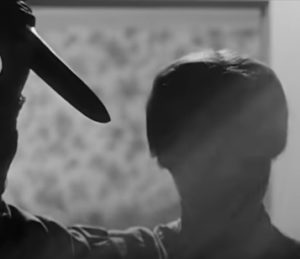 In the golden age of knife fighting literature (the seventies, eighties, and to some extent, the nineties) it was common knowledge, among self-appointed experts in the field, that any man who held a knife in a reverse grip with the edge out was a skilled and experienced blade fighter whose mere presence caused weaker men to burst into tears. This association of Reverse Grip Edge Out (RGEO) with skilled martial artists help propel the tanto fad of the era, as invariably those portrayed in martial arts magazines employing this grip were also using Japanese tanto-style blades to do it. Meanwhile, RGEI was typified in popular culture as the Norman Bates Psycho Overhand Stab, in which an unskilled person holding a kitchen knife simply charged you, blade down and edge in, while sawing their arm back and forth like a first-generation Star Wars action figure.
In the golden age of knife fighting literature (the seventies, eighties, and to some extent, the nineties) it was common knowledge, among self-appointed experts in the field, that any man who held a knife in a reverse grip with the edge out was a skilled and experienced blade fighter whose mere presence caused weaker men to burst into tears. This association of Reverse Grip Edge Out (RGEO) with skilled martial artists help propel the tanto fad of the era, as invariably those portrayed in martial arts magazines employing this grip were also using Japanese tanto-style blades to do it. Meanwhile, RGEI was typified in popular culture as the Norman Bates Psycho Overhand Stab, in which an unskilled person holding a kitchen knife simply charged you, blade down and edge in, while sawing their arm back and forth like a first-generation Star Wars action figure.
 Reverse grip was further popularized by a body of superb instructional work on the topic, such as the foundational Drawpoint material from James Keating. At one point, there was at least one Kydex sheath-maker marketing “disposable drawpoint” packages for expedient self-defense, consisting of a cheap fixed blade suitable for reverse-grip, draw-and-stab methods and featuring a very handy inside-the-waistband sheath. The assumption many exponents of knife combatives made for years was that knife carried for reverse grip, either on the belt or in the waistband, would be drawn from the strong side, either at the three o’clock or four o’clock position. This is a relatively straight draw that would become either an iaido-style slash upward or an up-and-down, draw-and-stab motion. There is no danger to the user, or very little danger, and the method is both expedient and powerful. It foregoes much of the stylized nonsense associated with “knife fighting” of the era in favor of putting the knife deeply and quickly into the other guy.
Reverse grip was further popularized by a body of superb instructional work on the topic, such as the foundational Drawpoint material from James Keating. At one point, there was at least one Kydex sheath-maker marketing “disposable drawpoint” packages for expedient self-defense, consisting of a cheap fixed blade suitable for reverse-grip, draw-and-stab methods and featuring a very handy inside-the-waistband sheath. The assumption many exponents of knife combatives made for years was that knife carried for reverse grip, either on the belt or in the waistband, would be drawn from the strong side, either at the three o’clock or four o’clock position. This is a relatively straight draw that would become either an iaido-style slash upward or an up-and-down, draw-and-stab motion. There is no danger to the user, or very little danger, and the method is both expedient and powerful. It foregoes much of the stylized nonsense associated with “knife fighting” of the era in favor of putting the knife deeply and quickly into the other guy.
Training evolves, and the evolution of edged weapons combatives — what we once called, in our foolish younger years, knife fighting — is no exception. Contemporary instructors now recognize the viability of carrying a blade closer to the centerline of the body, where the arms naturally fall. The result of this influence is an increasing number of knives carried in or around (or opposite to) the “appendix” position to complement firearms carried the same way. But while these knives are more easily drawn in a real fight from a position in which the defender is more likely to find himself, they require drawing the weapon across the body in a way that the drawpoint reverse grip style does not. The result is that when a knife — such as one of the popular fruit knives customized for self-defense — is drawn across the body from the belt line, it has the potential to cut its way through whatever it touches. The safer way to do it is to make sure the edge of the knife is oriented up, with the spine of the blade (the back of the blade, which is unsharpened) toward the belt/waistband.
A typical example of such carry was provided to The Martialist by our friends at Delta2Alpha (check out their Facebook and Instagram pages). The knife is carried under the belt in its Kydex sheath. The lanyard is used as an anchor, so the sheath doesn’t fall to the ground when the knife is drawn. The strong side hand grabs the knife (in this case, the right hand), using the notch as an index, and the knife comes out of the sheath with the blade pointed up and the flat of the blade moving along the waistband/beltline.
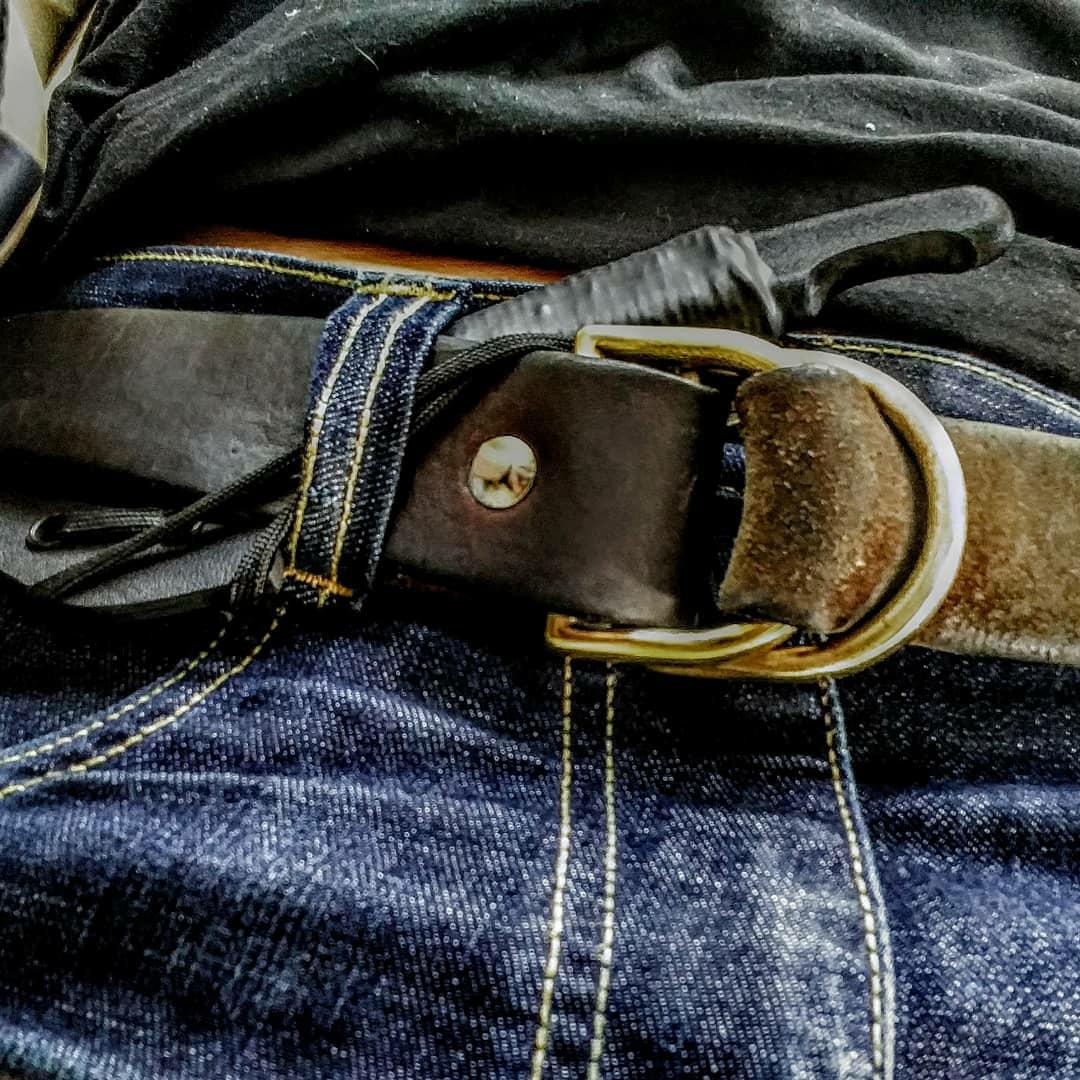
The pictures here tell the tale. Imagine the knife, rather than on top of the belt, sheathed beneath it. The reverse grip, edge-out carried knife, especially a bird’s beak style blade as shown here, runs a very distinct risk of cutting fabric, belt, and even flesh as it comes out of a deeply carried sheath. Any type of hooked, curved blade, such as a kerambit or other hawkbill, exacerbates this problem.
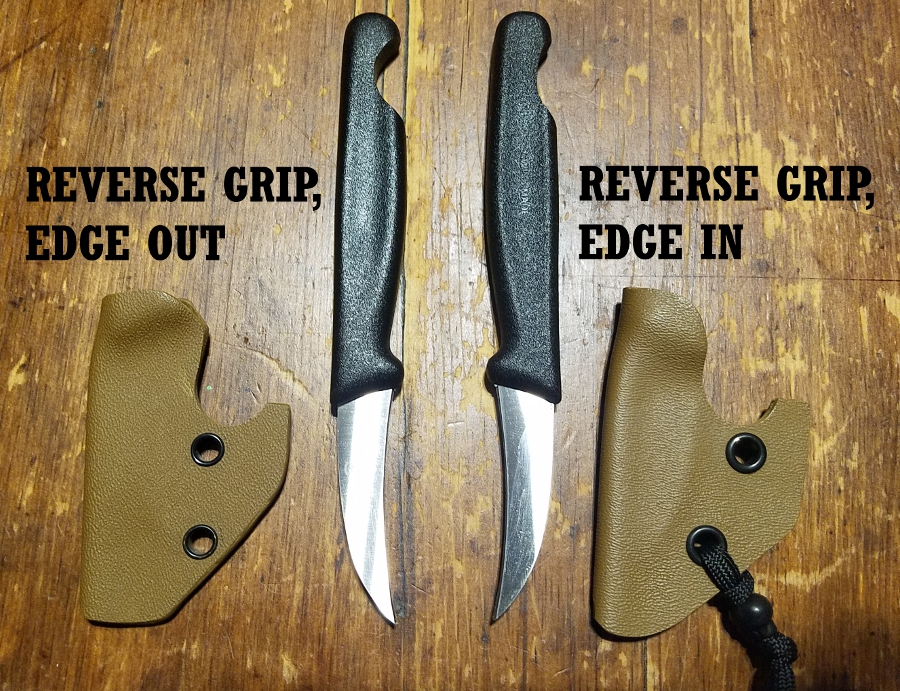
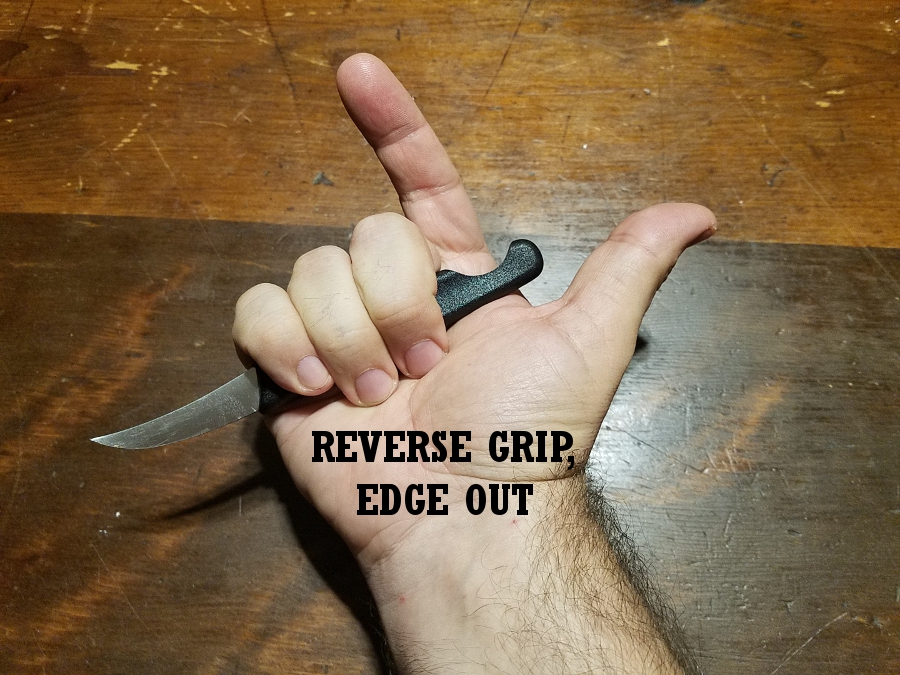
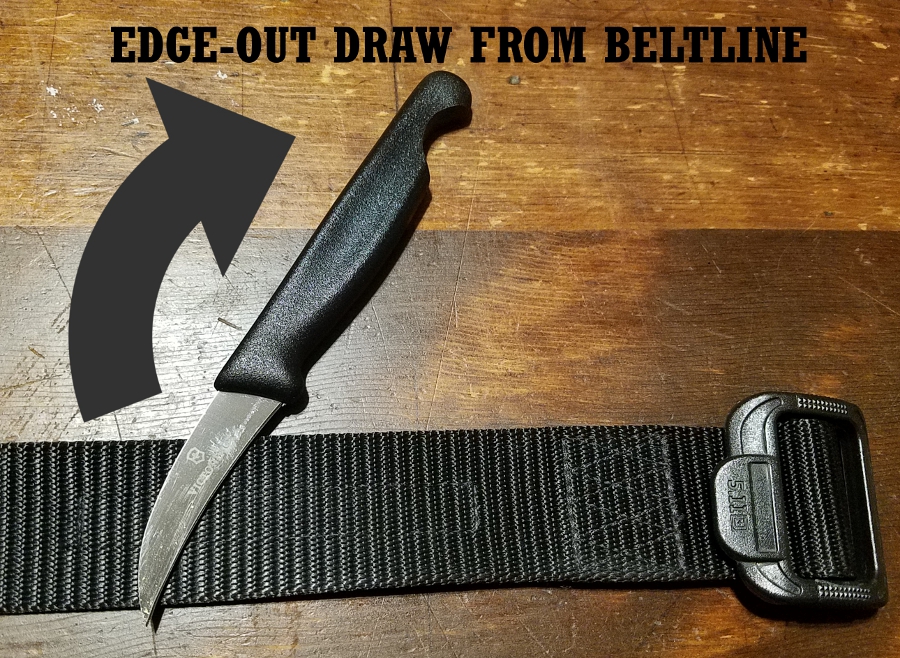
The arc of a knife carried for pikal, by contrast, carries it up and out of the sheath in such a way that it is the flat of the blade that touches the waistband or the body, not the edge.
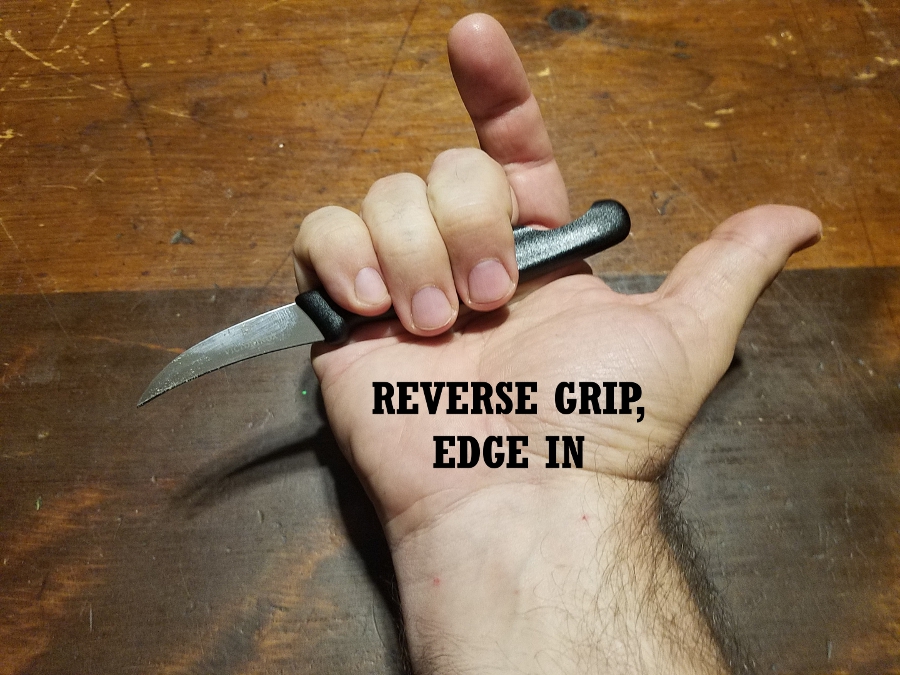
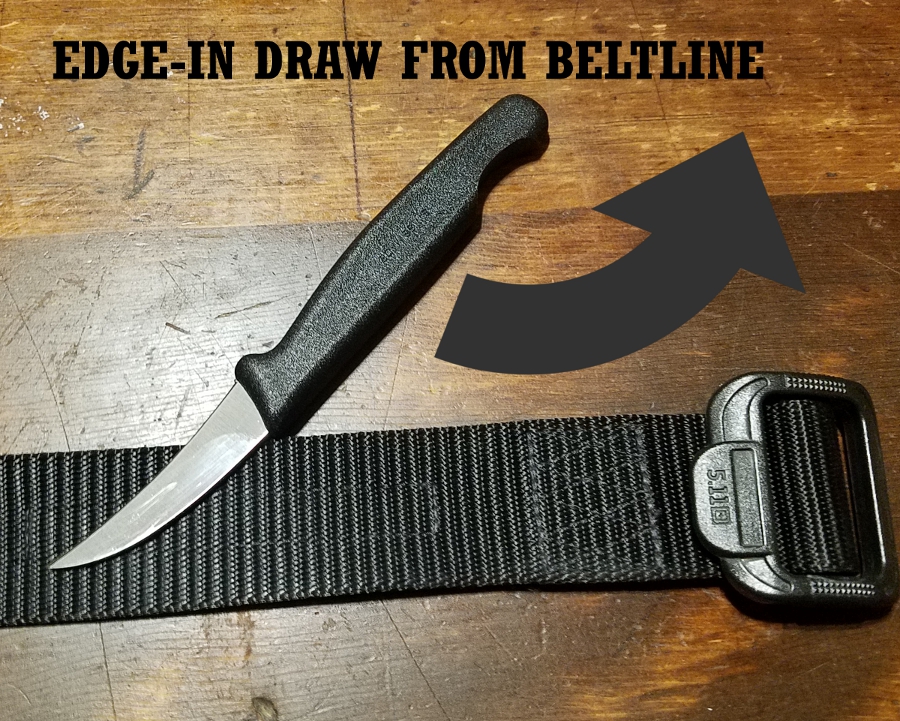
This is not, of course, a condemnation of RGEO or an advocacy of only RGEI. Only your training and practice can dictate what you do. If you practice your drawstroke and application regularly, under realistic conditions, you will find the flaws in your methods when they simply don’t work. At least, you fill find those flaws that are immediately disqualifying, such as a drawstroke that damages your clothes or your person.
A huge problem in the “tactical community,” if you’ll allow me that term, is that too many people never bother to engage in this type of practice. They buy the latest popular knife, put it on, play around with it a little, and never really push themselves to see if they could deploy and use the knife under realistic levels of stress and opposition.
I’ve said this so many times that they might as well chisel it into my tombstone: The time to discover you’re unprepared is before an emergency, not during it. Whatever system of carrying and deploying a fixed blade you are using right now, take a very hard and honest look at what will happen when drawing that knife under stress. If your system is not consistent, is not reproducible under stress, and presents any sort of potential danger to your person or accessories, it is time to reevaluate it.
Maybe you’re writing this for people who already recognize or are familiar with all the references, but I have to ask you if those knives are modified steak or paring knives because I have not seen anything like that for sale.
Actually they suggest that even a Mora Companion or such could be used. The designs are totally adaptable to similar knives. My second question is, are they considered very effective? They are rather short and narrow compared to most blades on any fixed or folding knife that people usually choose for self defense.
This is the first time I see or read about knives like these or these concepts you have covered.
These are Victorinox paring knives modified with finger notches. They are available for sale at http://www.EnginesOfMayhem.com . They are fairly effective, yes.
I have practiced extensively with the Vic paring knives with the notch (RGBI). They are very effective, used as designed, you are capable of ripping someone completely apart. They were designed to be utilzed with your Lat/ Trap muslces which are extremely powerful and hard to defeat. The small blade is designed for ripping( pulling thru a object) action, the resulting blood loss, tissue destruction, shock is mind altering. If you search http://www.librefightingmethod.com, you will see just how effectively dangerous that little blade is!